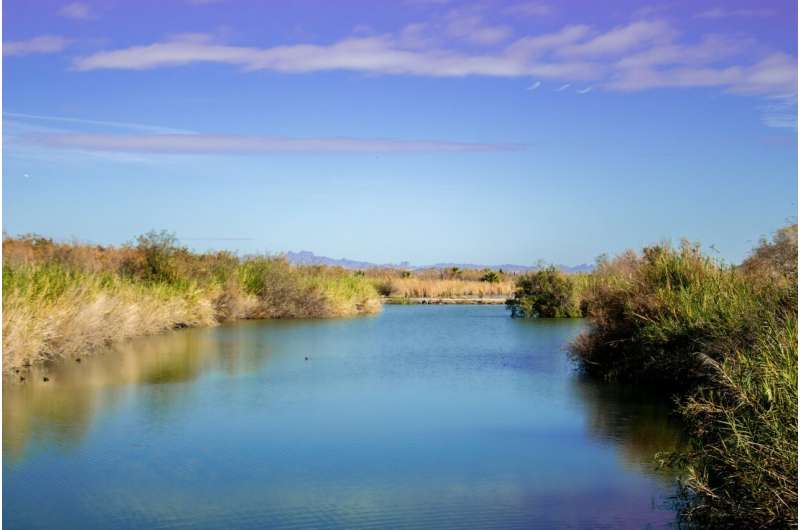This article has been reviewed according to Science X's editorial process and policies. Editors have highlighted the following attributes while ensuring the content's credibility:
fact-checked
reputable news agency
proofread
At Southern Nevada Water Summit, leaders share hope for Colorado River

Two years after Lake Mead hit an all-time low and concern swelled for the Colorado River's long-term sustainability, water managers and lawmakers generally see a healthier basin. But that didn't come without sacrifice in Las Vegas.
U.S. Rep. Susie Lee, D-Nev., brought together federal, state and local leaders at Springs Preserve on Wednesday for her second annual Southern Nevada Water Summit. Decision-makers painted a hesitant, yet more hopeful view for the river that provides drinking water for 40 million people across seven states, Native American tribal lands and parts of Mexico.
Since the founding of the Southern Nevada Water Authority in 1991, the state, which is afforded the smallest portion of the river by far, has emerged as a leader in the West in conversations about how cities can reduce their usage through aggressive policies.
"The influence of this state on the management of the river cannot be overstated, especially when you practice what you preach on water conservation," said Camille Calimlim Touton, the Bureau of Reclamation commissioner who grew up in Las Vegas and was once an intern with the water authority.
Heated negotiations, presidential election looms
The discussions come at a critical time as states try to come to a consensus on how to allocate the river after its 2007 guidelines expire in 2026. Negotiations are underscored by a presidential election; whoever ends up in the White House this year could greatly re-shape Reclamation leadership.
Lee highlighted funds from the Bipartisan Infrastructure Law that have totaled $141 million in projects for water in Southern Nevada, including funding for the Las Vegas Wash, which carries millions of gallons of treated wastewater to Lake Mead.
"We've seen 120-degree days in Southern Nevada. Water and climate change are on people's minds, and people are seeing the impacts of the investments we've been able to make," Lee told reporters.
Nevada, joined by California and Arizona in the Lower Basin, disagree with northern states—Colorado, Utah, New Mexico and Wyoming—on the best way to deal with the river's shortfalls that are only worsening as drought persists.
The Lower Basin has argued that the Upper Basin should have to shoulder cuts past what's known as the "structural deficit," or the 1.5 million acre-feet of river water lost because of transport and climate change. The Upper Basin has argued that it already experiences an estimated shortage of 1.2 million acre-feet due to climate change. Nevada's chief negotiator told the Las Vegas Review-Journal in March that he was unconvinced by the Upper Basin's data.
Though Touton offered no sweeping opinions or assessments of the dueling proposals, she praised the groups for agreeing that it's the Lower Basin's task to deal with the structural deficit.
"How do we live in this community and live with less?" Touton asked. "These are hard conversations."
If states cannot come to a consensus themselves behind closed doors, it's likely that Reclamation would intervene.
It's possible that the issue could make its way to the U.S. Supreme Court if states file legal challenges, said Colby Pellegrino, the water authority's deputy general manager.
"You don't want somebody in a black robe deciding how and when you use your water," Pellegrino said. "Climate change is such a Herculean task. … I really think you guys need to play nice in the sandbox and figure this out, but you all need to share the pain."
Las Vegas leads the way
While Lake Mead's success these past two years is largely because of good snowpack in the Rocky Mountains, water conservation still plays an important role.
And no place in the West has pursued conservation as comprehensively as Southern Nevada, from mass grass removal projects to government ordinances banning new golf courses.
Alfalfa—and agriculture at large, mostly not based in Nevada—continues to suck up the most water from the river every year by far, with 52 percent of total use in the Colorado River Basin, according to a study released this year. City, commercial and industrial use accounts for only 18 percent of river usage.
But savings add up over time. Pellegrino spoke of the region's efforts to make homes tap into city sewer systems rather than septic systems and Southern Nevada's infrastructure that allows it to recycle almost every drop of water that's used indoors.
"Like any community, we have sins in our past," she said. "There are choices we made during development that are not palatable today. Anybody familiar with Lake Las Vegas? It would not get approved today."
It's important, too, to keep an eye on projections for Lake Mead and Lake Powell, the country's two biggest reservoirs, Reclamation hydrologist Shana Tighi said. Officials shared that August's projection, which will decide if Nevada will take on further cuts in usage, will be released Thursday.
"Yes, it's painful," Tighi said of water management needed to sustain the river. "But it's working."
2024 Las Vegas Review-Journal. Distributed by Tribune Content Agency, LLC.




















